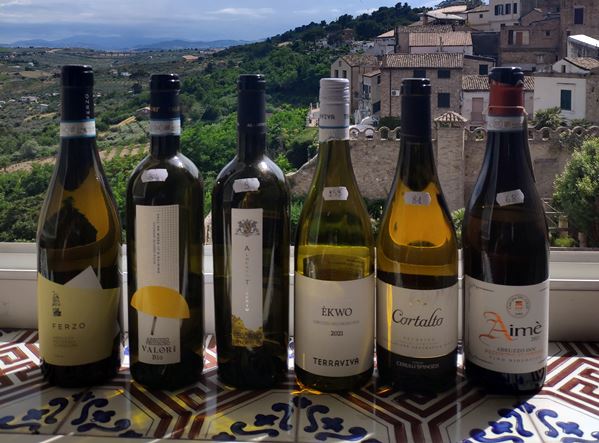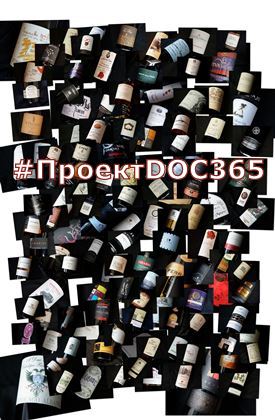Pecorino progress
28 Июня 2022The white variety that contends for leadership in Abruzzo
 PECORINO FROM ABRUZZO
PECORINO FROM ABRUZZO
Text: Eleonora Scholes
Photo: spaziovino.com
“When we think of Abruzzo, we first of all think of red Montepulciano. In reality, Abruzzo has rich white heritage”, says Giovanni D’Alesio from D’Alesio family winery. At least five local white varieties contend to be image grapes for the region’s white wines. High stakes are placed on Pecorino. There are many reasons why this variety that was only recently neglected is quickly becoming Abruzzo white leader.
Some twenty years ago Pecorino was almost unheard of. Trebbiano d’Abruzzo was the most known white wine from Abruzzo. Yet in 2022 a leading Italian wine guide gave top awards to five Pecorino wines. This was the third of fifteen awards from Abruzzo. The list included five red Montepulciano d’Abruzzo wines, the same number as Pecorino. The results are impressive.
How come that in a relatively short period Pecorino took over Trebbiano? Not so much in terms of production volumes, but in recognition?
Trebbiano in Abruzzo is complicated. End consumer never knows which Trebbiano is used in Trebbiano d’Abruzzo wine. It might be Trebbiano Abbruzzese which is capable of giving outstanding wines, but is little cultivated. More likely it will be neutral Trebbiano Toscano which was mass planted in Abruzzo in the era when quantity was more important than quality. As a consequence, Trebbiano d’Abruzzo wines may taste very differently. For an average consumer they are not always interesting or exciting because they are not expressly fruity, even if some wines such as Valentini (made with Trebbiano Abruzzese) are among Italian legends.
Pecorino is another story. Its appealing character is obvious. The wines are expressive, perfumed, fresh, with floral aromas, rounded white, tropical and citrus fruit. Light chalky minerality adds interest. The flavours are with presence and persistence. The styles vary from vibrating, with an accent on citruses to match seafood to rather dense, structured wines which go with complex dishes.
“Pecorino appeals to those who like Sauvignon Blanc, Viognier or Albarino”, says Rodrigo Redmont, owner-winemaker of Talamonti winery. In other words, thanks to its bright profile Pecorino can have and already has a big circle of fans.
Winemakers value Pecorino for high quality, but it wasn’t always like that. Pecorino’s low yield was until recently its drawback rather than advantage. By 1980s its cultivation almost disappeared. The turning point came in 1986 when Luigi Cataldi Madonna from the eponymous winery was the first to bottle Pecorino as a varietal wine. Before Pecorino, if it was used at all, was a secondary blending grape. Cataldi Madonna is considered as Pecorino pioneer in the region. He was soon followed by others.
International markets quickly embraced the wines’ high quality and attractive taste. These days hardly any winery in Abruzzo ignores Pecorino. The motivation to produce Pecorino wines is also economic. “We can ask for higher prices while working with lower yields”, notes Rodrigo Redmont.
Whilst Pecorino was most probably born in the Marche region, it is hard to argue that it became widely popular thanks to Abruzzo wines. They are produced along all the 130-km-long coast. Wines are also made in the internal areas of Abruzzo up to the Apennines.
In order to preserve the wines’ floral-fruity character and natural freshness, vinification normally takes place in neutral environment, that is in steel vats. They are used both for everyday wines in medium price segment and for serious premium wines. Vinification techniques vary from one estate to another. They may include wine aging on fine lees, batonnage, additional aging in bottles, etc.
In the northern part of Abruzzo bordering Marche we find Tenuta Terraviva. It is one of those small family estates with excellent reputation. “Our vineyards grow on calcareous clay soils just a kilometre away from the sea”, says Pina Marano. She owns Tenuta Terraviva together with her husband Pietro Topi. Pecorino vineyards looking over the sea have different age. Old vines over 50 years are reserved for top-of-the-range Ekwo. Grapes from younger plantings go into Abruzzo Percorino. Vinification is the same for both: spontaneous fermentation in steel vats with controlled temperature and further 6-months aging. The difference in taste comes exclusively from the vineyards.
Let’s now move from the northern to the southern coast close to the border with Molise. Family winery Alberto Tiberio is based in Casalbordino. “As for local white grapes, we cultivate Pecorino and Cococciola. Both are historic varieties, but the interest to them is recent. Pecorino has more acidity, wines are fresh”, comments Alessandra Tiberio. Pecorino from Alberto Tiberio comes across as a dense, complex wine.
When talking about the wines from the northern and the southern coasts, they have in common chalky minerality and salty taste. Both are influenced by the proximity of the sea. “Pecorino is a typical coastal grape”, says Alessandra Tiberio. Nonetheless, Pecorino from the internal areas of Abruzzo can also be impressive.
“We have two Pecorino wines. One, just Pecorino, has become our flagship. People call it Il Pecorino (The Pecorino)”, notes Paola Russano. She is responsible for sales in the family winery Pasetti. This is the only Abruzzo estate with vineyards in the Gran Sasso national park. Gran Sasso is the highest mountain of the Apennines. Vineyards with mountain climate are situated in two villages at 450 and 550 metres above sea level. Collecivetta is among the finest Pecorino wines in Abruzzo. It is made with selected grapes from the north-eastern facing vineyard at 550 metres. Vinifcation is in steel vats. The wine’s richness is accentuated thanks to 6-months aging on fine lees with further aging in bottles.
The area of Loreto Aprutino, mid way between Pescara and the mountains, is one of the best terroirs for white wines in Abruzzo. “If in other areas priority is given to Montepulciano and red grapes, Loreto Aprutino is mostly about white winemaking. The plantings of white varieties account for over 70 per cent”, says Rodrigo Redmont. Talamonti winery, owned by Redmont and his wine Antonella Di Tonno, has 60 hectares of vineyards. Pecorino takes ten hectares. The variety was planted in 2004-2011 at 300 metres above sea level. Highly reputed Trabocchetto, Pecorino based wine, is classified as Abruzzo Superiore. This means that the wine has lower yield and is released on the market later than others.
Talking about Pecorino aging, the key for understanding can be found in D’Alesio. The estate deliberately releases all its wines, not just Pecorino, late when it deems wines to be ready. Now Pecorino 2021 and to lesser extent 2020 are sold on the market. D’Alesio current vintage is 2018.
The estate’s vineyards are located near Citta Sant’Angelo, a historically important place for winemaking. Abruzzo Pecorino Superiore is produced since 2014. The wine spends two years in steel vats and the same amount of time in bottles. Lanfranco D’Alesio together with his nephew Giovanni opened for comparison two Abruzzo Pecorino Superiore – 2018 and 2017. The former is mature and rich, with smooth flavours and propoli nuances. The latter comes from the outstanding vintage for white wines in Abruzzo. Five-year-old Pecorino Superiore 2017 impresses with freshness, harmony and young lifted aromas. It will develop gracefully for at least the next five years.
“Pecorino in Abruzzo doesn’t yet have a long track record, but in theory it should live in the bottle longer than Trebbiano”, says Giovanni D’Alesio. The future will show what Pecorino is really capable of. Its current progress, though, leaves no doubt. Pecorino is set to be the white leader of Abruzzo.
Короткая ссылка на новость: http://www.spaziovino.com/~LBHER
-
Fattoria Le Pupille Saffredi 1987–2006
Celebrating the 20th anniversary of an acclaimed Super-Tuscan
-
Pecorino progress
The white variety that contends for leadership in Abruzzo
-
Bordeaux grapes in Bolgheri
What’s happening in the leading estates – Le Macchiole, Ornellaia, Sassicaia
-
Salcheto Salco Evoluzione 1999 – 2001
The art and the evolution of a Tuscan wine
- Все материалы "English reviews"






